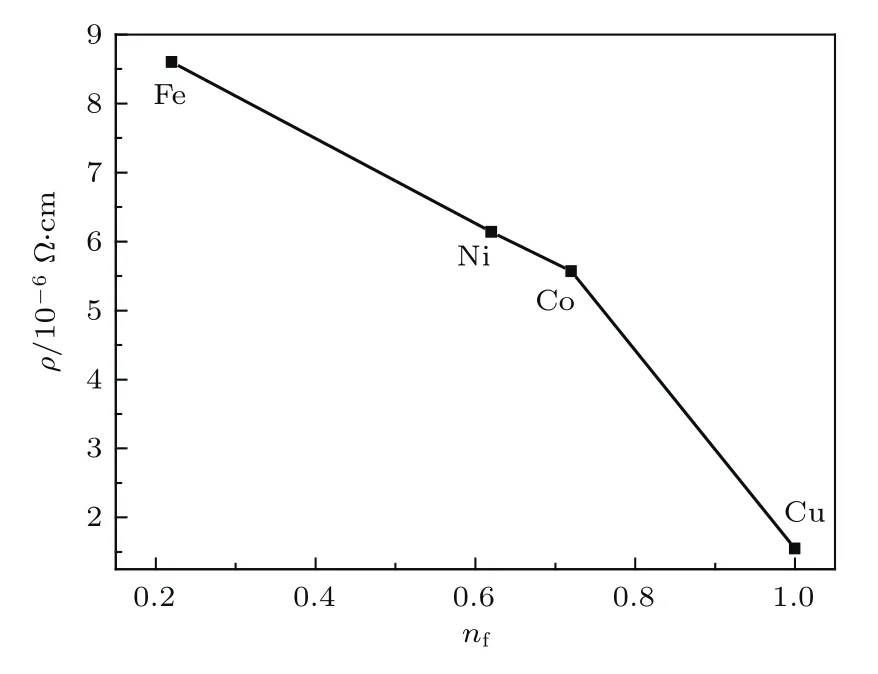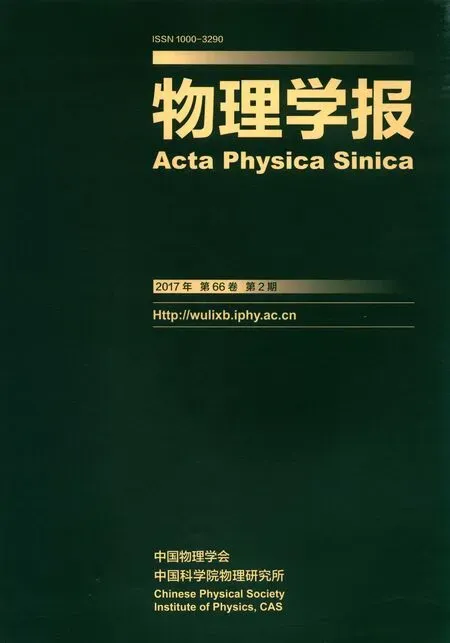金属价电子结构对磁性和电输运性质的影响∗
齐伟华 马丽 李壮志 唐贵德吴光恒
1)(河北师范大学物理科学与信息工程学院,河北省新型薄膜材料实验室,石家庄 050024)
2)(北京凝聚态物理国家实验室,中国科学院物理研究所,北京 100190)
金属价电子结构对磁性和电输运性质的影响∗
齐伟华1)马丽1)2)李壮志1)唐贵德1)†吴光恒2)
1)(河北师范大学物理科学与信息工程学院,河北省新型薄膜材料实验室,石家庄 050024)
2)(北京凝聚态物理国家实验室,中国科学院物理研究所,北京 100190)
(2016年10月10日收到;2016年11月8日收到修改稿)
本文以原子物理学中电子按能级分布理论为基础,提出一个关于金属磁性的新的巡游电子模型:在形成金属的过程中由于受到电子间泡利排斥力的作用,Fe,Ni,Co原子的大部分4s电子进入3d轨道,只有一少部分4s电子成为自由电子;最外层3d轨道的电子有一定概率在离子实间巡游,形成巡游电子;其余的3d电子为局域电子.因此,由Fe,Ni,Co金属的平均原子磁矩实验值2.22,0.62和1.72µB,计算出Fe,Ni,Co金属中平均每个原子贡献的自由电子数目为0.22,0.62和0.72,从而解释了为什么Fe,Ni,Co金属的电阻率依次减小.应用这个模型计算出的平均每个原子的3d电子数为7.78,9.38和8.28,与金属能带论计算结果(7.4,9.4和8.3)比较接近,但是本文的方法更加简单、有效,易于理解.这为进一步澄清金属与合金的价电子结构提供了新思路.
金属的电子结构,电输运,磁性
1 引 言
从物理学常用数表[1]和铁磁学教科书[2,3]中容易查到铁磁性金属Fe,Co,Ni的平均原子磁矩、居里温度和电阻率的实验值,如表1所列.对于Fe,Co,Ni的平均原子磁矩,目前公认的解释以金属能带论为基础[2-5].X射线光电子谱实验和密度泛函理论计算都证明[4,5],在这些金属的费米能级以下约6 eV的范围内连续分布着价电子.自旋角分辨光电子谱证明在费米能级附近,自旋向下的电子(少数自旋)分布概率明显大于自旋向上(多数自旋)的电子[4,5].实际上,只有在费米能级以下0.03 eV以内的价电子能够在室温下热激发到导带.所以绝大部分价电子是局域电子.根据金属能带论研究结果,对于金属Fe中每个原子来说,其自旋向上和向下的3d电子数目分别为4.8和2.6,自旋向上和向下的4s电子数目都是0.3[2].自旋向上和向下电子总数的差为2.2,从而解释了单个原子磁矩平均为2.2µB的实验结果.但是这样的能带论计算结果不能解释为什么Fe,Ni,Co的电阻率依次减小,以及为什么Ni的居里温度远低于Fe和Co.为此,本文提出一个新模型,定性解释这些问题.

表1 几种金属的平均原子磁矩(µobs)、居里温度(TC)和电阻率(ρ)实验值,以及3d与4s电子总数nds,金属中3d次壳层的电子数(nd=10-µobs)和自由电子数(nf=nds-nd)Table 1.Experimental values of average magnetic moment(µobs)per atom,Curie temperature(TC)and electrical resistivity(ρ)for several metals,and total number(nds)of their 3d and 4s electrons,3d electron number(nd=10-µobs)and free electron number(nf=nds-nd).
2 关于金属磁性和电性关系的电子结构模型
根据金属的自旋角分辨光电子谱[4,5]和样品的电阻率实验结果[1],我们提出一个关于金属磁性和电性关系的电子结构模型.1)在3d过渡族原子结合成金属的过程中,由于受到原子间电子的泡利排斥力的挤压作用,原子的大部分4s电子进入3d轨道,变成3d电子,剩余的4s电子作为自由电子;2)由于进入3d轨道的4s电子数目平均值不是整数,一部分原子就会比另一部分原子多出一个3d电子,这种多出的3d电子在邻近原子间发生跃迁,形成巡游电子,其余的3d电子都是局域电子;3)金属的电阻率随自由电子含量的增加而减小.巡游电子跃迁的概率远小于自由电子.所以,与自由电子相比,巡游电子跃迁对金属电阻率的贡献较小.
由于3d过渡金属原子有5个3d轨道.根据洪特定则,当3d电子数目nd≤5时,电子自旋都排列在一个方向上,一般称为自旋向上.当nd>5时,多出的电子自旋反向排列,称为自旋向下.由于Fe,Ni,Co的3d电子数目大于5,所以其原子磁矩应为

把表1中样品磁矩的实验值代入(1)式,容易算出在Fe,Ni,Co金属中原子的平均3d电子数目nd分别为7.78,9.38和8.28,其中局域电子数目为7,9和8,巡游电子数目为0.78,0.38和0.28;自由电子的平均数目nf分别为0.22,0.62和0.72.Cu原子有10个3d电子,1个4s电子.由于3d轨道已经填满电子,金属Cu的自由电子平均数目为1.00.我们发现一个非常有趣的结果:这些金属电阻率的实验值随nf的增加而减小,如图1所示.
根据金属能带论的计算结果,在Fe,Ni和Co金属中平均每个原子的3d电子数目分别为7.4,9.4和8.3[2],与表1的数据很接近,只有Fe的3d电子数目与我们用磁矩实验值计算的结果偏离较大.这说明我们的模型可以用金属能带论解释.但是我们的模型给出了更加清晰的物理机制和一个利用磁矩实验数据研究金属价电子结构的简单而有效的方法,这可以给众多材料学实验研究者带来方便.
注意到Ni金属中原子的3d电子平均数目为9.38.这说明在金属Ni中,38%的原子有10个3d电子,属于满壳层的较稳定结构.这种满壳层结构的3d电子能量较低,不容易发生巡游,相当于掺入了Cu或Zn.这必然导致金属Ni的居里温度降低.所以Ni的居里温度只有631 K,远低于Fe的1043 K和Co的1404 K.

图1 Fe,Ni,Co,Cu的电阻率随自由电子平均数目的变化关系Fig.1.Dependence of electrical resistivity for Fe,Ni,Co and Cu on the free electron number.
根据固体物理学,如果把原子实看成互为相切的硬球,由于铁磁性的Fe和Co分别为体心立方和六角密堆积结构,在Co中硬球间的自由空间明显小于Fe的自由空间,导致在Co中巡游电子的跃迁概率较高,这可能是Co的居里温度高于Fe的一个原因.
我们提出的这个巡游电子模型与Stearns[6,7]提出的dl-di电子之间交换作用模型的相似之处,在于都认为过渡金属中3d电子分成巡游电子和局域电子.但是Stearns的模型只解释了金属磁矩的大小,我们的模型不仅解释了金属磁矩的大小,而且定性解释了居里温度和电阻率与金属磁矩的关系.
3 结 论
基于本文提出的磁性金属中的巡游电子模型,定性解释了Fe,Co,Ni的电阻率和居里温度与磁矩之间的关系.根据这个模型,金属Fe,Co,Ni中原子磁矩的非整数值是由于在原子结合成金属的过程中大部分4s电子进入3d轨道,变成3d电子;少部分4s电子变为自由电子.金属的电阻率随自由电子平均数目的增加而减小.由于3d电子的平均数目不是整数,造成一部分原子比另一部分原子多出一个3d电子,这个多出的3d电子形成巡游电子,其余的3d电子都是局域电子.
[1]Ida S,Ono K,Kozaki H(translated by Zhang Z X)1979Data on Physics in Common Use(Beijing:Science Press)p133(in Chinese)[饭田修一,大野和郎,神前熙 编(张质贤 译)1979物理学常用数表 (北京:科学出版社)第133页]
[2]Dai D S,Qian K M 1986Ferromagnetism(Beijing:Science Press)p320(in Chinese)[戴道生,钱昆明1986铁磁学 (上册)(北京:科学出版社)第320页]
[3]Stöhr J,Siegmann H C(translated by Ji Y)2012Magnetism:From Fundamentals to Nanoscale Dynamics(Beijing:Higher Education Press)p450(in Chinese)[Stöhr J,Siegmann H C 著 (姬扬 译)2012磁学:从基础知识到纳米尺度超快动力学 (北京:高等教育出版社)第450页]
[4]Johnson P D 1997Rep.Prog.Phys.60 1217
[5]Sánchez-Barriga J,Minár J,Braun J,Varykhalov A,Boni V,Marco I D,Rader O,Bellini V,Manghi F,Ebert H,Katsnelson M I,Lichtenstein A I,Eriksson O,Eberhardt W,Dürr H A,Fink J 2010Phys.Rev.B82 104414
[6]Stearns M B 1973Phys.Rev.B8 4383
[7]Stearns M B 1978Phys.Today31(4)34
PACS:71.10.-w,72.15.-v,75.50.Cc DOI:10.7498/aps.66.027101
Dependences of valence electronic structure on magnetic moment and electrical resistivity of metals∗
Qi Wei-Hua1)Ma Li1)2)Li Zhuang-Zhi1)Tang Gui-De1)†Wu Guang-Heng2)
1)(Hebei Advanced Thin Film Laboratory,College of Physics and Information Engineering,Hebei Normal University,Shijiazhuang 050024,China)
2)(Beijing National Laboratory for Condensed Matter Physics,Institute of Physics,Chinese Academy of Sciences,Beijing 100190,China)
10 October 2016;revised manuscript
8 November 2016)
Conventionally,the energy band theory is used to explain the magnetic and electrical transport properties of metals.However,so far,there has been no quantitative explanation of the relations between the average magnetic moment per atom and the resistivity for Fe,nor Ni,nor Co metals.In this paper,a new itinerant electron model for magnetic metal is proposed on the basis of electron distribution theory at the energy level.1)In the process of free atoms forming the metal solid,most of the 4s electrons of Fe,Ni and Co enter into the 3d orbits subjected to the Pauli repulsive force,and the remaining 4s electrons form free electrons.2)Since the average number of 3d electrons is not an integer,a part of atoms have one 3d electron more than the other atoms.These excess 3d electrons have a certain probability to itinerate between the 3d orbits of the adjacent atoms as itinerant electrons;and the other 3d electrons are local electrons.3)The transition probability of itinerant electrons is very low,thus the contribution to metal resistivity from itinerant electrons is far lower than that from free electrons.Resistivity of metal decreases with increasing the number of free electrons.Therefore,using the observed values of average atomic magnetic moments,2.22,0.62 and 1.72µB,the average numbers of free electrons in Fe,Ni and Co can be calculated to be 0.22,0.62 and 0.72,respectively.This is the reason why the electrical resistivities of Fe,Ni and Co(8.6,6.14 and 5.57µΩ-cm)decease successively.In addition,according to this model,the average number of 3d electrons per atom in Ni metal is 9.38.This indicates that 38%of atoms in Ni metal have ten 3d electrons,forming a full 3d sub-shell,as in Cu or Zn atoms.The 3d electrons in these atoms are difficult to itinerate or exchange.This may be the reason why the Curie temperature of Ni metal(631 K)is far lower than those of Fe and Co metals(1043 and 1404 K).On the basis of the energy band theory,the numbers of 3d electrons in Fe,Ni and Co metals are 7.4,9.4 and 8.3,which are close to our results(7.78,9.38 and 8.28),respectively.This indicates that our model is consistent with the energy band theory.Compared with the complex energy band theory,a simple and effective method on investigating valence electron structures through the experimental average magnetic moments per atom in a metal is presented based on our model.Therefore,the new itinerant electron model may be a new clue to understanding the electronic structure of metals and alloys.
electron structure of metals,electrical transport,magnetic property
:71.10.-w,72.15.-v,75.50.Cc
10.7498/aps.66.027101
∗国家自然科学基金(批准号:11174069)、河北省自然科学基金(批准号:A2015205111)、河北省应用基础研究计划重点基础研究项目(批准号:16961106D)和河北省教育厅青年基金(批准号:QN2016015)资助的课题.
†通信作者.E-mail:tanggd@hebtu.edu.cn
*Project supported by the National Natural Science Foundation of China(Grant No.11174069),the Natural Science Foundation of Hebei Province,China(Grant No.A2015205111),the Key Item Science Foundation of Hebei Province,China(Grant No.16961106D),and the Young Scholar Science Foundation of the Education Department of Hebei Province,China(Grant No.QN2016015).
†Corresponding author.E-mail:tanggd@hebtu.edu.cn

